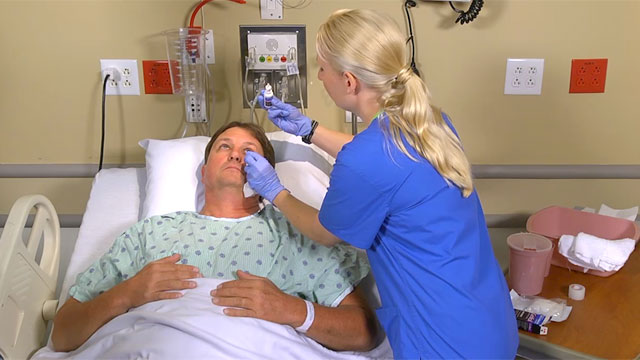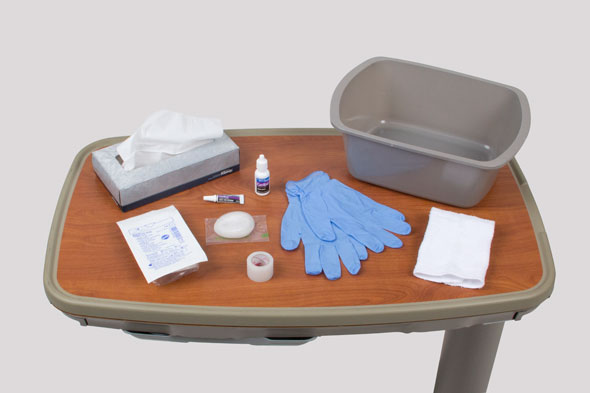Nonparenteral Medication Administration
Select a Skill:
- » Applying Topical Medications
- » Applying an Estrogen Patch and Nitroglycerin Ointment
- » Administering Eye Medications
- » Administering Ear Medications
- » Using a Metered-Dose Inhaler
- » Using a Dry Powder Inhaler
- » Inserting a Rectal Suppository
Take the Review Test:

Safety
- Ensure that the Six Rights of medication administration are followed: right medication, right dose, right patient, right route, right time, and right documentation.
- When using eyedrops or eye ointments, patients should not share medications with others, because the risk of transmitting infection is high.
- When both eyedrops and eye ointment are ordered, administer the drops first, wait 3 minutes, and then administer the ointment. This allows time for each medication to have an effect.
- Mydriatics (agents used to dilate the pupils) will temporarily blur vision. Wearing sunglasses will reduce photophobia. Caution patients receiving medications that paralyze the ciliary muscles of the eye (e.g., scopolamine, Isopto-Hyoscine, atropine, Isopto Atropine, and cycloplegics) not to drive or attempt to perform any activity that requires acute vision after receiving the medication.
- Do not hyperextend the neck of a patient with a cervical spine injury.
- Avoid applying eye medications directly onto the sensitive cornea, which has a rich supply of nerve fibers. Instead, instill medications into the conjunctival sac.
Equipment
(Roll cursor over items to see labels)

Prescribed medication
Clean gloves
Tissues or cotton balls
Basin
Washcloth and towel
Eye patch (optional)
Tape (for eye patch)
Sterile gauze pads
Delegation
The skill of administering eye medications cannot be delegated to NAP. Be sure to inform NAP of the following:
- The expected therapeutic effects of the medication, and the potential side effects that should be reported to you
- The potential for temporary visual impairment after administration of eye medications
Preparation
- Check the accuracy and completeness of the medication administration record (MAR) against the health care provider’s medication order.
- Note the patient’s allergies.
- Read carefully the manufacturer’s instructions for application or administration.
- Observe the Six Rights of Medication Administration: right medication, right dose, right patient, right route, right time, and right documentation. (For details, see the Video Skill “Ensuring the Six Rights of Medication Administration.”) Note the eye being treated (right, left, or both) and the number of drops to instill.
- Prepare medications for application. Check the medication label against the MAR two times. Check the expiration date on the container or package.
- If eyedrops are stored in refrigerator, allow them to come to room before giving them.
Follow-up
- Ask the patient or a family member to name the medication and state its action, purpose, dosage, schedule, and possible side effects.
- Observe the patient or family member applying the eye medication, and provide reinforcement of appropriate technique as needed.
- Note the patient’s response to the medication by assessing for vision changes, asking if symptoms have been relieved, and noting any side effects.
Documentation
- Record the time of administration, the type and strength of the medication applied, the number of drops instilled, and the application site (right, left, or both eyes) in the MAR immediately after administration, not before. Include your initials or signature. Record patient teaching and validation of the patient’s understanding.
- Document objective data related to the eye tissue involved (e.g., redness, drainage, irritation) as well as any subjective data (e.g., pain, itching, altered vision). Record the therapeutic response to the medication, as well as any adverse effects. Record the reason for any withheld medication, and follow agency policy for noting withheld doses.
Review Questions
1. What is the best way for the nurse to minimize the risk of contaminating the patient’s eye during the instillation of eye drops?
 Encourage the patient to self-apply the medication.
Encourage the patient to self-apply the medication. Wear gloves during the entire application process.
Wear gloves during the entire application process. Introduce the medication onto the inner canthus of the eye.
Introduce the medication onto the inner canthus of the eye. Perform effective hand hygiene before and after the instillation.
Perform effective hand hygiene before and after the instillation.
2. Which instruction should be given to a patient to ensure safety when self-applying an antibiotic ointment?
 It is not necessary to allow refrigerated eye medication to warm to room temperature before administration.
It is not necessary to allow refrigerated eye medication to warm to room temperature before administration. Do not apply pressure directly to the eyeball when removing excess medication.
Do not apply pressure directly to the eyeball when removing excess medication. When cleaning the eye before administration, gently wash from the outer to the inner canthus.
When cleaning the eye before administration, gently wash from the outer to the inner canthus. Apply a warm, damp washcloth to the eye for several minutes to remove any crusted discharge.
Apply a warm, damp washcloth to the eye for several minutes to remove any crusted discharge.
3. Which statement or question best illustrates the nurse’s understanding of the role of nursing assistive personnel (NAP) in the instillation of eye medications?
 “Did you let the eye medication warm to room temperature?”
“Did you let the eye medication warm to room temperature?” “Do you think the patient is capable of instilling his own eyedrops?”
“Do you think the patient is capable of instilling his own eyedrops?” “Be sure to slightly hyperextend her neck when instilling the medication.”
“Be sure to slightly hyperextend her neck when instilling the medication.” “Her vision may be temporarily impaired, so please help her to the bathroom.”
“Her vision may be temporarily impaired, so please help her to the bathroom.”
4. After instructing a patient in the self-administration of antibiotic eyedrops, what is the nurse's highest priority assessment?
 The patient’s understanding of the medication’s purpose
The patient’s understanding of the medication’s purpose  The patient’s hand grasp, strength, coordination, and ability to manipulate the applicator
The patient’s hand grasp, strength, coordination, and ability to manipulate the applicator The patient’s comprehension of the dosage instructions provided with the medication
The patient’s comprehension of the dosage instructions provided with the medication The patient’s ability to recognize the signs of an allergic reaction to the medication
The patient’s ability to recognize the signs of an allergic reaction to the medication
5. When placing an intraocular disk, the nurse recognizes that it is in the correct position by assessing what?
 Visibility of the disk over the cornea
Visibility of the disk over the cornea Lack of visibility of the disk as it is placed under the lower eyelid
Lack of visibility of the disk as it is placed under the lower eyelid Lack of visibility as it is placed under the upper eyelid
Lack of visibility as it is placed under the upper eyelid Visibility of a small portion of the disk extending slightly above the lower eyelid
Visibility of a small portion of the disk extending slightly above the lower eyelid
You have completed the Review Questions for this skill. To take the Review again select the Start Over button. To proceed to another skill select from the dropdown menu. Select the Home or Back button to proceed to the next section.


